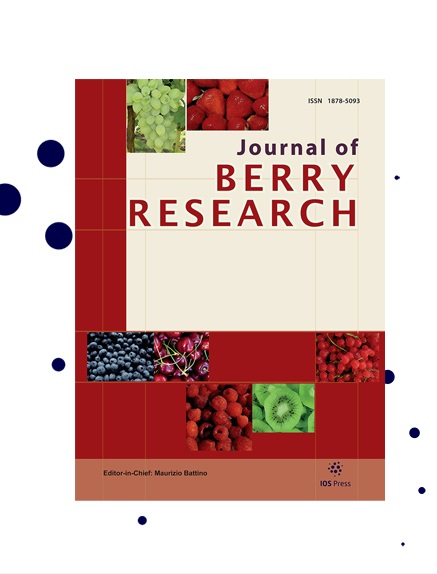Assessing genetic diversity of berberis genotypes selected from an F1 population using molecular markers
IF 1.4
4区 农林科学
Q3 PLANT SCIENCES
引用次数: 0
Abstract
Barberries are versatile shrubs with diverse applications, including ornamental, medicinal, and edible purposes. In this study, we employed molecular markers to assess the genetic diversity and genetic base of superior barberry genotypes selected from an F1 population obtained through Shahrood University Barberry Breeding Program (SUBBP), alongside their parents. We utilized nine ISSR markers and 10 RAPD markers to analyze the population’s genetic diversity. From these markers, we obtained 98 polymorphic bands using ISSR markers and 112 polymorphic bands using RAPD markers. The average PIC value was 0.16 for ISSR markers and RAPD markers, while the average genetic resolution power was 3.93 for ISSR markers and 2.11 for RAPD markers. Furthermore, we calculated the genetic dissimilarity coefficient (GDC) based on ISSR and RAPD markers, which ranged from 0.23 to 0.86 (average 0.62) and 0.21 to 0.85 (average 0.60), respectively. The ISSR data analysis classified the genotypes into three main clusters, with genotypes 0515, R5N1, ‘Bth’, ‘Seedless (BD)’, and R2N1 being genetically distant from the others. Similarly, the analysis of 10 RAPD primers resulted in the classification of genotypes into three main groups. Notably, genotype 0609 exhibited greater genetic distance from other genotypes in this subgroup. The Principal Coordinates Analysis (PCoA) using both ISSR and RAPD marker data further supported the grouping of genotypes into three distinct clusters. These results provide valuable insights into the genetic composition of the F1 population and contribute to the advancement of barberry breeding strategies.利用分子标记评价小檗F1群体基因型的遗传多样性
枸杞是用途广泛的灌木,有多种用途,包括观赏、药用和食用用途。本研究利用分子标记技术,对通过Shahrood University barberry Breeding Program (SUBBP)获得的一个F1群体及其亲本的优越基因型的遗传多样性和遗传基础进行了评价。利用9个ISSR标记和10个RAPD标记分析了该群体的遗传多样性。利用ISSR标记获得98个多态性条带,RAPD标记获得112个多态性条带。ISSR标记和RAPD标记的平均PIC值为0.16,ISSR标记和RAPD标记的平均遗传分辨能力分别为3.93和2.11。基于ISSR和RAPD的遗传不相似系数(GDC)分别为0.23 ~ 0.86(平均0.62)和0.21 ~ 0.85(平均0.60)。ISSR数据分析将基因型分为3个主要集群,其中基因型0515、R5N1、' Bth '、'无籽(BD) '和R2N1在遗传上与其他基因型相距较远。同样,对10个RAPD引物的分析结果将基因型分为三大类。值得注意的是,基因型0609与该亚群中其他基因型的遗传距离更大。利用ISSR和RAPD标记数据的主坐标分析(PCoA)进一步支持将基因型分为三个不同的簇。这些结果为了解F1群体的遗传组成提供了有价值的见解,并有助于提高小檗育种策略。
本文章由计算机程序翻译,如有差异,请以英文原文为准。
求助全文
约1分钟内获得全文
求助全文
来源期刊

Journal of Berry Research
Biochemistry, Genetics and Molecular Biology-Biochemistry
CiteScore
3.50
自引率
11.80%
发文量
21
期刊介绍:
The main objective of the Journal of Berry Research is to improve the knowledge about quality and production of berries to benefit health of the consumers and maintain profitable production using sustainable systems. The objective will be achieved by focusing on four main areas of research and development:
From genetics to variety evaluation
Nursery production systems and plant quality control
Plant physiology, biochemistry and molecular biology, as well as cultural management
Health for the consumer: components and factors affecting berries'' nutritional value
Specifically, the journal will cover berries (strawberry, raspberry, blackberry, blueberry, cranberry currants, etc.), as well as grapes and small soft fruit in general (e.g., kiwi fruit). It will publish research results covering all areas of plant breeding, including plant genetics, genomics, functional genomics, proteomics and metabolomics, plant physiology, plant pathology and plant development, as well as results dealing with the chemistry and biochemistry of bioactive compounds contained in such fruits and their possible role in human health. Contributions detailing possible pharmacological, medical or therapeutic use or dietary significance will be welcomed in addition to studies regarding biosafety issues of genetically modified plants.
 求助内容:
求助内容: 应助结果提醒方式:
应助结果提醒方式:


